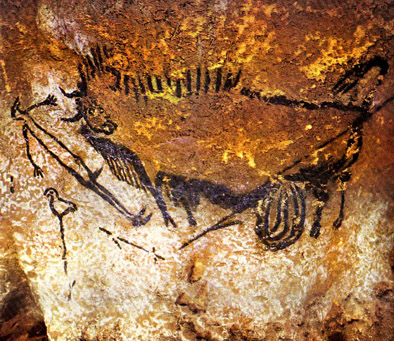According to the Wikipedia article on the caves, they were first discovered in 1940 by four teenagers and have been deteriorating ever since due to the overabundance of visitors to the site. A second set of caves were created in 1983 with replicas of the paintings in order to preserve the original artwork. The paintings date back thousands of years to the paleolithic era. One of the most enigmatic images is this one, wherein a man with a bird head lies prostrate next to what appears to be a large bison. There is of course the mysterious bird on a stick in the same frame.


Theories as to the meaning of this piece are varied, and debate continues as to its actual meaning. Some say the narrative is that of the hunt or of a ceremonial ritual relating to the hunt. Others theorize that the three figures represent stars and that the entire cave system is a map of the skies.
 In this interpretation, the three figures represent the three stars, Vega, Deneb, and Altair. Together, these three make up the Summer triangle as illustrated in the above diagram. The mythological significance of these three in relation to the constellations to which they belong is referenced in the hyperlink to their names. Some say that through this gateway, one can travel to new realms of consciousness. In Chinese mythology, however, there is another myth relating to the three in the story of the Herd-Boy and the Weaver-Girl. To sum up the full story (see hyperlink) the herd-boy stumbles upon seven immortal maidens who have come to earth to bathe in a stream. Parallels can be drawn here to the nine muses. The herd boy , seeing the youngest of the maidens, falls in love and steals her clothes so that she cannot return to the heaven. The article states, "She must marry him after he sees her unclothed, as was the local quaint custom of the time." Here, we can draw parallels to Ovid's telling of Diana and Actaeon. The theme of vital importance here is the witnessing of some secret ritual, the initiation of the unknowing.
In this interpretation, the three figures represent the three stars, Vega, Deneb, and Altair. Together, these three make up the Summer triangle as illustrated in the above diagram. The mythological significance of these three in relation to the constellations to which they belong is referenced in the hyperlink to their names. Some say that through this gateway, one can travel to new realms of consciousness. In Chinese mythology, however, there is another myth relating to the three in the story of the Herd-Boy and the Weaver-Girl. To sum up the full story (see hyperlink) the herd-boy stumbles upon seven immortal maidens who have come to earth to bathe in a stream. Parallels can be drawn here to the nine muses. The herd boy , seeing the youngest of the maidens, falls in love and steals her clothes so that she cannot return to the heaven. The article states, "She must marry him after he sees her unclothed, as was the local quaint custom of the time." Here, we can draw parallels to Ovid's telling of Diana and Actaeon. The theme of vital importance here is the witnessing of some secret ritual, the initiation of the unknowing.The story continues when his wife must return to her work in the heavens and the lovers are separated. The boy sneaks into heaven to see her by hiding himself in the skin of a water buffalo, but the two are separated again by a great river (the milky way). Here we have a great river, the river of dream? (The river of everything in the world, Finnegan's Wake??) Eventually, it is agreed that the couple can meet on the seventh night of the seventh month but only if the river is small so that the birds can form a bridge for the two to be together.
Regardless of any mythological significance, or perhaps in relation to it, the three stand as a gateway to higher consciousness. (See the Matrix and Plato's Allegory of the Cave). Dr. Felicitas Goodman theorizes that this depiction of the bird-man is the depiction of the shaman indulging in a "trance state". She says he is on a "spirit journey to the upper world". This article, explains the relation of the Lascaux images to her work on Trance Postures as a whole. Goodman theorizes that by adopting different postures depicted in multiple works of ancient art, one can achieve an altered state and transcend the physical. By doing this, one gains higher realization and interacts with a realm of existence we earthly bound know nothing about. More on her work on trance can be found here.
The tradition of cave painting for social commentary and further exploration of our world continues to this day through graffiti artists. One such artist is the infamous Banksy. I have included several of his more pertinent images below. Through artists such as these stretching back in time to the earliest man, we find our way through the caves of memory to infinite truths.



